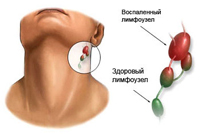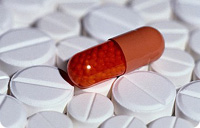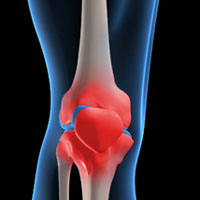Limph nodes increased? Look at yourself careful. What caused lymphadenitis and what is he - acute or chronic? From the answers to these questions directly depends on the treatment and recovery.
Content
- Influenza, angina, exudative diathesis, pyodermia
- Chronic inflammation of almonds (tonsillitis), pharyngitis, sinusitis,
- Caries, Stomatitis, gum inflammation (gingivitis), Glossites,
- rhinitis, inflammatory diseases of the ear,
- Common bacterial or viral infectious diseases: tularemia and brucellosis,
- Infectious mononucleosis (cervical) and rubella (ear), adenoviral infection
- Damage to the skin or mucosa of the mouth: At the place of injury, entrance doors are created for infection, furuncle
- Sarcoidosis (lesion of cervical, elbow and axillary lymph nodes)
- frequent inflammatory diseases of the genital organs (inguinal lymph nodes); infections (syphilis, herpes)
- Tuberculosis (cervical, submandibular and axillary lymph nodes), as well as vaccination against this disease
- HIV infection (many groups of lymph nodes) and others.

With an unfavorable flow, inflammation can go to purulent. The general condition worsens - the body temperature is strongly rising, there is airsdown, a breakdown, oznoby, heartbeat, headaches, is lost appetite and t. D. The node becomes low-propelled, soldering with other nodes, forming a package with them, softening appears in the center of the area of redness - a sign of the accumulation of pus. The inflamed lymph node is gradually melted and causes the formation of a fistula (with the transition of a disease in a chronic form) or the development of purulent inflammation of fiber.
Forecast for timely treatment favorable. The outcome of the disease is the scarring with the substitution of lymphoid tissue connective. In some cases, elephantity may develop due to the violation of the lymphottock.
Increased lymph nodes can be detected:
- Behind and ahead of the oars,
- on the sides of the neck,
- Under the lower jaw,
- Over the clavicle,
- armpits,
- on the side sides of the chest,
- in elbow grab,
- in groin.
An increase in one lymph node, not accompanied by pain, an increase in body temperature, progressing the growth of lymph nodes, is not a sign of the disease, but indicates that this lymph node - «hard worker», works more active than his fellow. Similar increase often arises on the background or after infections. Over time, lymph node can return to its usual sizes.
Chronic nonspecific lymphadenitis develops as a result of the destruction of the acute process or is caused by low-active microorganisms. The overall health of the patient is usually not impaired. Unbreamed nodes, but tight enough, on the touch separate, clearly defined. With a long action of the source of infection on the lymph node in the process of chronic inflammation, it gradually collapses, replaced by a connective tissue. Periodic exacerbations lead to the formation of a fistula, which in time closes and makes it wary. Then the fistula arises next.
Chronic specific lymphadenitis develops due to tuberculosis, syphilitic, etc. Chronic infections. As a rule, the mandibular, subband, trimmed and cervical nodes are affected, sometimes with lesion of lymph nodes in other parts of the body, including bronchial and retroperitoneal.









